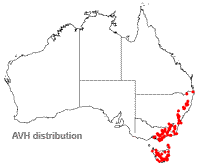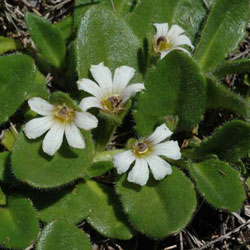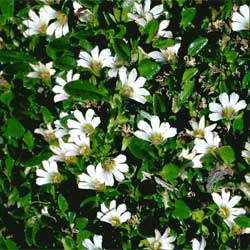Scaevola hookeri
Creeping Fan Flower
Scaevola hookeri (de Vriese) F.Muell. ex Hook.f.
The genus Scaevola belongs to the Goodeniaceae family which consists of several other well known genera including Damperia, Goodenia, Velleia, Lechenaultia and Coopernookia. Overall Scaevola contains 130 species which are widely distributed throughout Australia. The Scaevola genus is distinguished by their fan shaped flowers which can range in colour from white through to pale pink, lilac and mauve.
Scaevola hookeri is commonly known as the creeping fan flower, mat fan flower or alpine fan flower. It is a small, sub alpine, low growing perennial herb which forms dense mats spreading up to one metre in width. Scaevolahookeri provides a blanket of colour as it flowers profusely from late spring through to late autumn.
The beautiful solitary flowers grow on leafy racemes and range from 5-8mm in length with a slight feathery appearance on the petals edge. Another prominent feature is the brightly coloured throat of each flower which is predominantly yellow but is known to be white or blue on occasion which gives the overall plant an interesting contrast. Be sure to buy these plants while in flower to ensure you get a colour you are happy with because there is a lot of colour variation within this species.
Even when it’s not in flower the semi-succulent, irregularly toothed, dark green, glossy leaves provide a wonderful border or backdrop in rockeries, gravel terrain, driveway strips, and hanging pots or dotted throughout the garden. Scaevola, among other ground hugging species, is also now a common replacement in Australian gardens for flammable mulches such as bark chips and leaf litter.
 Scaevola hookeri, due to its alpine nature, is predominantly widespread throughout the high country of Tasmania, Victoria and New South Wales and is therefore snow and frost hardy to -7 º C. This type of distribution means that cultivation of S. hookeri can require some care. Ideally when growing S. hookeri, plenty of water and full sun to partial shade is recommended as well as an acidic, porous soil type, preferably made up of loam or gravel.
Scaevola hookeri, due to its alpine nature, is predominantly widespread throughout the high country of Tasmania, Victoria and New South Wales and is therefore snow and frost hardy to -7 º C. This type of distribution means that cultivation of S. hookeri can require some care. Ideally when growing S. hookeri, plenty of water and full sun to partial shade is recommended as well as an acidic, porous soil type, preferably made up of loam or gravel.
This ground hugging species roots at the nodes from stems which allows for ease of propagation via cuttings and division. It is prone to dying suddenly at the end of the flowering season so it is highly recommended that several cuttings be made during the growing season to have as replacements if necessary. To produce a viable cutting, remove some of the vegetative shoots by cutting off approximately 80 – 250 mm worth of material. Cut the stem at an angle and remove about ½ to 2/3 of the leaves from the bottom of the stem as well as any flowers or fruits. It’s also a good idea to dip the end in a standard semi hardwood rooting hormone but it’s not essential. Then place the cutting in a mix of river sand and loam, preferably in a shady spot, give it a good amount of water and give it 2-3 weeks. Propagation from seed is discouraged as limited success has been recorded and it is very easy to grow from cuttings.
The Scaevola genus is quite popular because of its resilience to pests and disease. If aphids or mealy bugs become a problem you can hose them off with a strong jet of soapy water or use a form of pesticide to eliminate them. Root rot is also an issue if you stress the plant by letting it dry out too much then soaking it with water.
Text by by Kate Brooks (2009 Botanical Intern)
Name Meaning: Scaevola hookeriScaevola – from the Latin word scaevus meaning on the left hand which refers to the one sided nature of the corolla. hookeri– after William Jackson Hooker, the Director of the Royal Botanic Gardens in Kew from 1841 – 1865. |
References
Angus Stewart (07/04/2007) Fact Sheet: Herbaceous Natives, Gardening Australia, ABC. Available at http://www.abc.net.au/gardening/stories/s1889853.htm
Australia’s Virtual Herbarium (AVH) (2009). Council of Heads of Australian Herbaria (CHAH). Available at http://www.cpbr.gov.au/chah/avh/index.html
George, A.S. (Ed.) (1992) Flora of Australia Volume 35, Brunoniaceae, Goodeniaceae, Australian Government Publishing Service, Canberra.
Rozefelds, A.C. (2001) The species of Scaevola (Goodeniaceae) in Tasmania. Telopea 9(2): 345–352.
SateFlora (2005) Scaevola hookeri, 2005 Autumn/Winter Photo Gallery. Department of Water, Land and Biodiversity Conservation, Government of South Australia. Available at http://www.stateflora.com.au/aw05p4.html
Taylor, D. (2009) Australian National Botanical Gardens. Personal communication.
TazWild Plants (n.d.) Tasmanian Native Plants and Wildflowers, Scaevola hookeri. Available at http://www.tazwild.com/plants/plant.php?plantID=207
Wrigley, J.W. & Fagg, M. (2003) Australian Native Plants, 5th edn, Reed New Holland.
![An Australian Government Initiative [logo]](/images/austgovt_brown_90px.gif)



